Roofing: Pressurization Poses Maintenance Challenges for Medical Center
For Tim Pennigar, the ninth floor of the patient tower at Duke University Medical Center did more than just occupy his thoughts during working hours.
"This is the floor that keeps me awake at night," says Pennigar, project manager for structural systems with the medical center, which is located in Durham, N.C.
The reason for the troubled sleep? The patient tower's roof had been a persistent problem, due to both water leaks that interfered with patient care and to intrusive odors related to improper ventilation and pressurization.
After completing a reroofing project earlier this year, Pennigar's nightmare has turned into something of a dream. The Durham area has received "monsoon" rains recently, Pennigar says, and he is "just delighted" with the performance of the new roof in the harsh conditions.
But the new roof's benefits go beyond protecting patients on the ninth floor, as well as valuable research taking place in the tower. It also offered the medical center an opportunity to minimize its impact on the environment.
Trouble on Top
The patient tower was built in 1979, and its 12,000-square-foot roof contains 1,100 linear feet of wall flashing. The complexity of its construction created problems for designers and installers.
The original roof included three different levels, a penthouse with two large intake fans, and a 70-foot-long, concrete-block, return-air plenum, which created high-velocity, negative-pressurization conditions.
As a result of the pressurization problem, torch use that created odor and smoke was not an option, and odor intrusion from roofing products was a major concern. Beyond that, the pressurization situation created problems related to moisture intrusion. Once the roof began to leak, the pressurization pulled water in unexpected directions.
"It was really difficult to track leaks," Pennigar says, adding that leaks in this type of facility are especially dangerous because they can quickly wipe out years of invaluable research or affect patient rooms.
Because of the critical nature of the patient tower and its operations, technicians often had to respond quickly to problems, and the situations typically required quick thinking. In one particular case, Pennigar says, workers trying to locate and fix a roof leak in a patient's room realized the patient could not move to another location. To remedy the situation, they injected urethane foam into the suspected area of the roof leak from inside the structure. This tactic diverted the water out of the patient's room into the hallway, where workers were able to collect it.
Related Topics:













